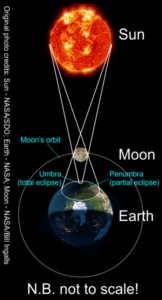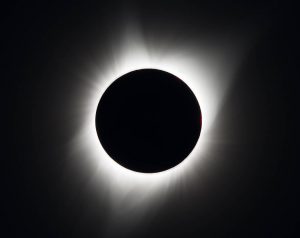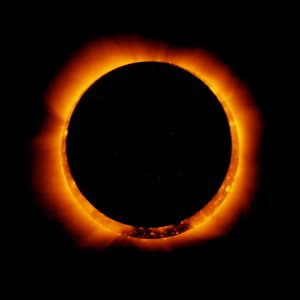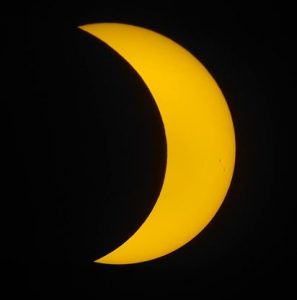
A solar eclipse occurs when the Moon passes between the Sun and an observer on the Earth‘s surface.
Since the Moon’s orbits plane is inclined by 5 degrees to that of ecliptic plane, (in which the Earth’s orbit path around the Sun lies) a solar eclipse does not occur at every new Moon.
Although solar eclipses occur more often than lunar eclipses, they are only visible to observers directly beneath the line traced by the Moon’s shadow over the Earth’s surface. Therefore, fewer people witness solar eclipses when they occur than lunar eclipses, which are observable anywhere on Earth where the Moon is visible.

Photo Credit: (NASA/Aubrey Gemignani)
Total Solar Eclipses
A total solar eclipse occurs when the Moon passes directly over the Sun’s disc, blocking it out completely.
Due to the coincidence that the Moon appears almost exactly the same same size in the sky as the Sun to an observer on Earth, the Moon can block out the Sun’s disc entirely, while allowing the Sun’s faint corona to become visible around the circumference of the Moon.
The total phase of a solar eclipse is the only time it is safe to look at the Sun directly.
Bailey’s Beads and the Diamond Ring
Bailey’s Beads is the name given to the effect during the beginning and end of the total phase of a solar eclipse, when the Sun’s rays peak out between mountain peaks or other topographical features on the edge of the Moon’s disc. The explanation for this effect, likened to a string of beads, was first given by Francis Bailey in 1836.
The “diamond ring” effect is produced when only one of these beads is visible, giving the appearance of a bright diamond set in the ring of the Sun’s corona.
Note that it is NOT safe to view either Bailey’s Beads or the Diamond Ring effect without proper eye protection. See “Safely observing a Solar Eclipse” below.
Partial Solar Eclipses
A partial solar eclipse appears to an observer on Earth when the Moon’s disc doesn’t line up entirely with that of the Sun. The observer of a partial solar eclipse is in the penumbra of the Moon’s shadow.
Both total and annular eclipses (see below) have a ‘partial phase’ before and after the Moon is completely aligned over the Sun’s disc.
Annular Solar Eclipses
An annular eclipse occurs when the Moon is near to it’s apogee – the furthest point from the Earth in its elliptical orbit – making it appear slightly smaller in the sky than the Sun’s disc. Rather than blocking out the Sun completely, as in a total eclipse, a circular ring of fire from the Sun’s photosphere is visible around the Moon’s disc, known as the annulus.

During an annular eclipse, the observer is positioned in the ‘antumbra’ of the Moon’s shadow.
Hybrid Solar Eclipses
The term hybrid solar eclipse refers to an eclipse that appears to be total near to the midpoint, but annular at other locations. This can occur because an observer at the start or end point of the path of the eclipse is further away from the Moon due to the curvature of the Earth.
Safely observing a Solar Eclipse
Warning: you should never look directly at the Sun (except during the total phase of a solar eclipse), as this could result in permanent blindness or damage to the eyes.
The safest way to view a solar eclipse is by projecting the Sun’s image through a pinhole projector. Welder’s glasses rated 14 or higher, or special eclipse eyeglasses can also be used. However, make sure that eclipse glasses are specifically designed for this purpose. Other types of translucent, coloured or smoked glass or film will not protect against the Sun’s UV rays and will result in permanent eye damage or blindness.
List of Recent and Upcoming Total Solar Eclipses
- 21 August 2017 – Visible across the United States
- 02 July 2019 – Visible in the Pitcairn Islands, central Argentina and Chile and the Tuamotu Archipelago
- 14 December 2020 – Visible in Southern Chile and Argentina
- 04 December 2021 – Visible in Antarctica
- 20 April 2023 – Hybrid eclipse visible in Indonesia, Australia, Timor-Leste
- 08 April 2024 – Visible in Mexico, central and northeastern United States
- 12 August 2026 – Visible in the Arctic, Greenland, Iceland, Spain and Northeastern Portugal
- 02 August 2027 – Visible in Morocco, Spain, Algeria, Tunisia, Libya, Egypt, Saudi Arabia, Yemen and Somalia
- 22 July 2028 – Visible in Australia and New Zealand
- 25 November 2030 – Visible in Botswana, South Africa and Australia
For a full list of total, annular, hybrid and partial solar eclipses in the 21st century, visit https://en.wikipedia.org/wiki/List_of_solar_eclipses_in_the_21st_century
